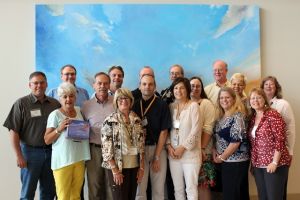- Subscribe to RSS Feed
- Mark as New
- Mark as Read
- Bookmark
- Subscribe
- Printer Friendly Page
- Report Inappropriate Content
08-19-2014
03:00 PM

In celebration of National Aviation Day, August 19, our Corporate Archiving Intern Anna Weinberger (pictured above on the right) shares her experience at a recent Aviation Archivist Summit event hosted at Southwest’s Headquarters in Dallas. As the Corporate Archiving Intern this summer, I have to confess something: I don’t know much about airplanes. You want to discuss preserving photographs? Great! You’re interested in the easiest way to catalogue LUVLines (our internal Employee magazine) for future use? Me too! You want to talk about how important the DC-3 was to the transformation of the airline industry before WWII? I’m not your girl. However, I had a unique opportunity in mid-July that has started to change my mind. A few weeks ago, the Corporate Archiving Team at Southwest Airlines was lucky enough to host the annual Aviation Archivist Summit—a conference where airline museum curators, archivists, and historians come together to discuss the best way to preserve an airline’s past. Discussions ranged anywhere from how to best preserve film negatives to why old time tables are the most worthwhile resource when discussing an aircraft’s history.
 As I sat around listening to all these airline history professionals, I began to see how so many people can fall in love with an airline. When I started this internship, I didn't know what to expect in an airline’s corporate archive. A part of me thought it would be all about the planes. However, from what I’ve seen these past three months, it’s more than that—it’s about preserving an entire Culture.
While fellow corporate archivists from Alaska Airlines, American, Boeing, and United were present, we also had the pleasure of hosting a few museums from across the country. Curious about the past of Northwest Airlines or TWA? Interested in seeing an original DC-3? Here are a few airline museums from across the country that collaborated with Southwest during the Summit you may not have heard of:
As I sat around listening to all these airline history professionals, I began to see how so many people can fall in love with an airline. When I started this internship, I didn't know what to expect in an airline’s corporate archive. A part of me thought it would be all about the planes. However, from what I’ve seen these past three months, it’s more than that—it’s about preserving an entire Culture.
While fellow corporate archivists from Alaska Airlines, American, Boeing, and United were present, we also had the pleasure of hosting a few museums from across the country. Curious about the past of Northwest Airlines or TWA? Interested in seeing an original DC-3? Here are a few airline museums from across the country that collaborated with Southwest during the Summit you may not have heard of:
- The TWA Museum (Kansas City, MO): A museum dedicated to Trans World Airline’s 75 years in commercial aviation, the TWA Museum has everything from uniforms to a 1937 Lockheed Electra Junior 12A.
- American Airline’s C.R. Smith Museum (Fort Worth, TX): Full of American Airlines history, as well as a “Flightlab” dedicated to teaching curious patrons how airplanes fly, The C.R. Smith Museum is also the home of many unique AA artifacts. Not to mention, their 1940 Douglas DC-3, Flagship Knoxville.
- 1940 Air Terminal Museum (Houston, TX): Dedicated to showcasing Houston’s airports and their connections to aviation history, the 1940 Air Terminal Museum is a great place to brush up on airline history and its connections to Texas.
- NWA History Centre (Bloomington, MN): A history center featuring the past of Northwest Airlines and its affiliates, the NWA History Centre has a plethora of artifacts, photographs and video from the mid-1920s and beyond.
You must be a registered user to add a comment. If you've already registered, sign in. Otherwise, register and sign in.